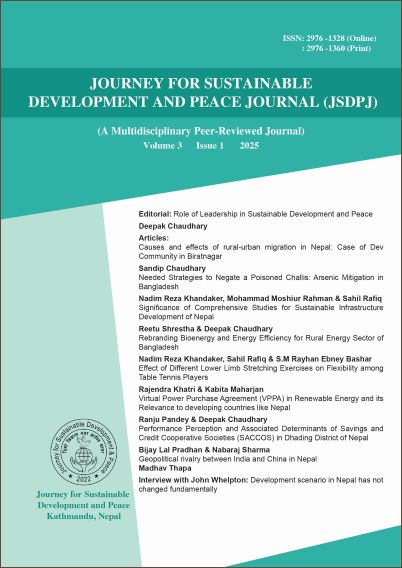Needed Strategies to Negate a Poisoned Challis: Arsenic Mitigation in Bangladesh
DOI:
https://doi.org/10.3126/jsdpj.v3i1.75566Keywords:
Arsenic, Bangladesh, South Asia, potable-water, mitigationAbstract
The arsenic contamination of groundwater in Bangladesh, first detected in 1993, remains a significant public health crisis, affecting millions of people. Despite decades of mitigation efforts, including interventions from the government, international agencies, and NGOs, arsenic contamination persists, particularly in rural areas. The crisis, which has led to chronic arsenic poisoning and various health issues, calls for more effective, sustainable solutions. This paper reviews the current state of arsenic contamination in Bangladesh, highlighting the complex hydrogeological conditions and the demographic impact of this issue. The approach focuses on the use of accessible arsenic testing kits, responsible utilization of deep arsenic-free aquifers, and affordable, locally manufactured water treatment technologies. This strategy aims to empower local stakeholders and provide self-reliant, scalable solutions to mitigate arsenic exposure, promoting health and sustainability in rural communities. The proposed solutions are designed to be adaptable to other arsenic-affected regions in South Asia, offering a model for addressing the arsenic crisis in resource-constrained environments.
Downloads
Downloads
Published
How to Cite
Issue
Section
License

This work is licensed under a Creative Commons Attribution-NonCommercial 4.0 International License.
This license enables reusers to distribute, remix, adapt, and build upon the material in any medium or format for noncommercial purposes only, and only so long as attribution is given to the creator.




